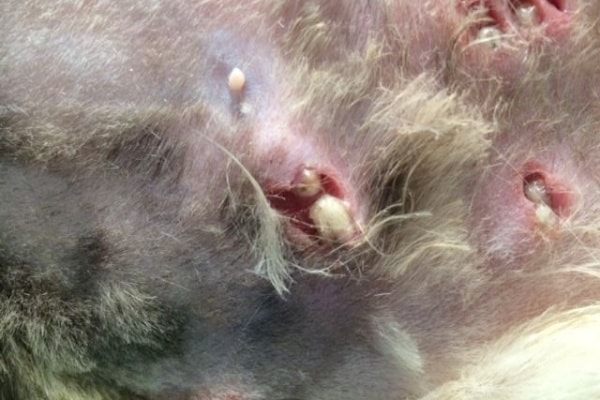
As a dedicated pet owner, you know the dangers of parasite infestation in dogs, and mango worms are no exception, but how do dogs get these pesky larvae that implant themselves in the dog’s skin?
How do dogs get mango worms? Dogs can get mango worms when they touch soil that is contaminated with larvae while spending time outdoors. Once they get into your dog, mango worms will nest under the skin and cause an infection that’s impossible not to notice. They will cause bumps and holes in the dog’s skin over time.
Stop these parasitic larvae from starting a nursery under your dog’s skin. In the following, you’ll learn more about mango worms and how to eliminate and prevent them in your dogs.
Understanding Mango Worms in Dogs
Dogs love to play outdoors and go for walks, but once they come in contact with newly hatched larvae, mango worms can start implanting themselves in their new host within 25 seconds.
This could happen to any dog who lives in a region known to have mango flies.
What Are Mango Worms?
Mango worms are the larvae of the mango fly or the Cordylobia anthropophagi, a Greek term that translates to “human eater.”
However, it’s not just humans that these parasitic worms infect. They have a choice of hosts from mammals, including your dogs.
These mango worms burrow under the skin of their mammal host, burrowing faster in thin skin than thick skin.
Mango worms usually stay on the surface of the skin for a week or two before eating the host’s inner skin as they continue to grow.
Once mature and ready to pupate, they will burst out of the skin, transform from a maggot into an adult mango fly that lays batches of 100 to 300 eggs at a time, and so the disgusting cycle continues.
What Causes Mango Worms in Dogs?
Dogs can get mango worms from soil or grass containing freshly hatched larvae.
They could simply be running around in the backyard, going for a walk, or digging and lying on the contaminated soil, and they can be at risk for contracting mango flies.
Mango flies can lay their eggs anywhere there are favorable conditions, like a damp cloth or bedding left outdoors.
Clothing that has dropped to the infected ground and air-dried beddings are other items where mango flies can leave their eggs.
These larvae can survive for around two weeks without a host, but once they come into contact with your dog, they will painlessly burrow under the skin.
Where Are Mango Worms Located?
Mango worms are endemic to Central Africa and have been documented there for over a hundred years, especially in tropical parts of sub-Saharan Africa.
Their preferred environment are places where the temperature and humidity are high.
However, this parasite has also made an appearance and accidental spread in other areas where it was never seen before, most likely transported via travel as they can also get into clothing.
Mango worms are also found in other parts of Africa (south and east) as well as in Uganda.
Are Mango Worms Common in the US?
One thing to know about mango worms is that it is a rare infestation in the US, but even rare infestation cases are possible.
Hence, it’s always smart to know a few things about these parasitic larvae to increase your pets’ protection and safety.
Are Bot Flies the Same as Mango Worms?
No, bot flies are not the same as mango worms. Mango worms that mature into mango flies (also called tumbu flies) are one of the six species of the small group of African blowflies called Cordylobia.
They are biologically similar to bot flies or Cuterebra from the family Cuterebridae, except that mango flies are smaller in size.
Are Mango Worms Harmful?
Mango worm infestation in dogs can lead to significant pain and discomfort, especially as the worms grow.
There can also be a high chance of skin infection happening when the infestation is left untreated.
In severe cases, mango worms can implant themselves deeper in your dog’s skin tissues and cause other serious problems like gangrene.
Are Mango Worms Painful?
As mango worms start growing and fattening themselves, at around eight to 12 days, they will start forming boils in your dog’s skin.
Those wounds can get very itchy and painful for your four-legged friend.
Mango Worms in Dogs Feet
The dog’s paws and feet are the most common places to have mango worms. Once they run or walk on contaminated soil or grass, the worms will quickly attach to their paw pads.
However, you may also see mango worms popping up in the dog’s face or their back. but the most dangerous area for dogs to have mango worms are on their lips.
It can happen when they dig and nose on contaminated soil. Mango worms on the lips are more likely to cause infections and complications during the removal process, so antibiotics are often prescribed.
Can Dogs Survive Mango Worms?
Mango worm infestations are not considered life-threatening or fatal, which means dogs with mango worms can survive.
However, it’s important to understand that they are still dangerous. So, it’s necessary to get your furry friend the proper treatment as soon as you notice signs and symptoms of mango worms in your dog.
Otherwise, your dog may suffer discomfort and pain from the boils and may even experience some visible health problems in the long run.
Symptoms of Mango Worms in Dogs
Mango worm infestation in dogs usually includes symptoms such as:
- Intense scratching
- Reddened skin
- Lumps forming on the skin, usually looking like small red pimples
- Blister-like lesions on the dog’s skin with a small opening in the middle that might ooze liquid
- Bald spots
- Behavioral changes, most likely due to the discomfort and pain on their skin
However, some dogs may not show most of these signs of infections in the early stages until the mango worms have gotten considerably bigger.
So, it’s important to check your dog’s skin and fur regularly for anything out of the ordinary if you live in a region known to have these pests.
Mango Worms in Dogs Treatment
If you suspect that your dog has a mango worm infestation, contacting a trusted veterinarian immediately is strongly recommended.
The quickest way to remove these parasitic worms is to push them out of the dog’s skin like you would a pimple, especially in the later stages.
However, you must refrain from doing it yourself as it can do more harm than good if done incorrectly.
When the maggots are not properly taken out, they could break, and parts of the worm could remain in the skin, rot, and cause further complications.
Usually, after the worms are removed, pets can go home if the infestation is mild.
Otherwise, the vet may recommend the next step of treatment, which is to use an antibiotic solution to clean the boils. Some vets may also prescribe your dog an oral antibiotic.
Mango Worms in Dogs Prevention
Parasites like mango worms invade your dog’s body and stress the immune system. That’s why it’s important to take some preventative measures.
These are very helpful, especially if you live in a rather risky area where there’s a large population of mango flies.
- Use fly repellants and insecticide sprays for flies you see indoors.
- Clean up for anything that can attract flies, like fallen fruits in the backyard or your pet’s urine and feces.
- Avoid leaving sweaty clothes lying around or outdoors.
- Machine wash your laundry, preferably at high temperature, and tumble dry clothes and bedding.
- If possible, iron clean clothes and bedding to kill eggs and larvae when line dried.
- Avoid hanging your washing outdoors, especially when you’re living in high-risk areas.
- Avoid allowing your pet to run around in damp soil or in any questionable area.
- Check your dog’s skin regularly, especially when living in or visiting high-risk areas.
- Ask your vet for pet-friendly insect repellant for your pet.
Related Questions:
Can People Get Mango Worms?
Yes. Mango worms can infect all mammals, from household pets to humans. The signs and symptoms of mango worms in dogs are a lot similar to mango worm infestations in humans.
The prevention tips above will also keep you and other humans at a lower risk from this parasite.
Do Cats Get Mango Worms?
Yes. The main hots of mango worms are mammals, including cats. They usually get it from grass or soil with larvae, the same as with dogs.
Conclusion
Parasites and other pests like mango flies may be lurking in the backyard.
If you prefer your dog’s skin to be hole-free, like any dog owner would, it’s important to take precautionary measures to prevent mango fly infestation in dogs, especially if you are in high-risk areas.
Warning: Graphic video may upset some people.




